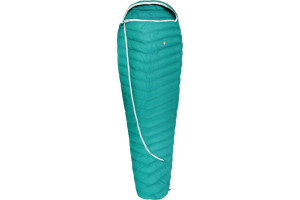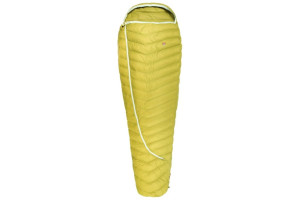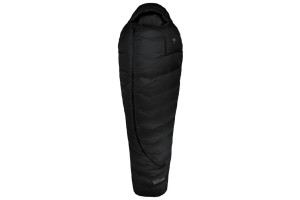Sleeping bags
When and where will you use the sleeping bag?
The most important thing when buying a sleeping bag is to think carefully about when and where you will mainly use it. Are weight and volume important because you will go cycling or do some serious trekking? Or will you use a sleeping bag at the campsite in a sunny, warm environment, where sleeping comfort is decisive and weight and volume are unimportant?
Comfort temperature
The insulation value of your sleeping bag is indicated in temperatures. A common misunderstanding is the assumption that the comfort-limit temperature is used to indicate how warm your sleeping bag is. ‘My sleeping bag is rated to -5ºC’, chances are this is the limit-comfort-temperature. In this case, the actual comfort temperature for you will often be somewhere between 0ºC and -5ºC. But even this is not necessarily true. As cold is experienced very individually. If you would lie in this sleeping bag at -2ºC, there is a fair chance you won't have a very enjoyable night.
The comfort temperature (highest temperature indicated) is the temperature at which the sleeping bag is comfortable for most people. The lowest temperature (extreme limit) indicates the temperature at which the sleeping bag can no longer protect you from hypothermia. This is a test value that follows from the EN-standard test. You actually hope never to experience this temperature with the sleeping bag because you really have ended up with the wrong sleeping bag in far more extreme conditions.
A sensible approach when buying a sleeping bag is to start from the comfort temperature and take your personal characteristics into account. If you get cold easily, choose a sleeping bag with a slightly lower comfort temperature or use an extra sleeping bag liner. If you are simply almost always too warm at night, focus more on the comfort limit value (often the middle temperature value mentioned on a sleeping bag).
The requirement for comfort temperatures, however, is that you lie on an insulating underlayer. You flatten the padding in your sleeping bag with your body, which reduces its ability to insulate. So the right sleeping mat together with the right sleeping bag form the basis for your sleeping comfort.
Comfort temperature: and where do the numbers come from?
To indicate how warm a sleeping bag is, there is an EN standard. We won't bore you with the details, but the test produces three values that are important: the ‘comfort temperature’, the ‘comfort limit’ and the ‘extreme’ temperature. At the comfort temperature an average woman can still sleep comfortably, at the ‘lower limit’ a standard man can just barely sleep comfortably and at the ‘extreme’ temperature a ‘standard woman’ can survive 6 hours without hypothermia.

 Europe - English (EUR)
Europe - English (EUR)  The Netherlands - Nederlands (EUR)
The Netherlands - Nederlands (EUR)  Belgie - Vlaams (EUR)
Belgie - Vlaams (EUR)  Denmark - Dansk (DKK)
Denmark - Dansk (DKK)  Germany - Deutsch (EUR)
Germany - Deutsch (EUR)  England - English (GBP)
England - English (GBP)  France - Français (EUR)
France - Français (EUR)  Italy - Italiano (EUR)
Italy - Italiano (EUR)  Spanje - Español (EUR)
Spanje - Español (EUR)  Poland - Polski (PLN)
Poland - Polski (PLN)  Austria - Deutsch (EUR)
Austria - Deutsch (EUR)  Zweden - Svenska (SEK)
Zweden - Svenska (SEK)  Swiss - Deutsch (CHF)
Swiss - Deutsch (CHF)  Canada - English (CAD)
Canada - English (CAD)  United States - English (USD)
United States - English (USD)  Middle East North Africa - Arabic (USD)
Middle East North Africa - Arabic (USD)  International - English (USD)
International - English (USD) 









































































































































